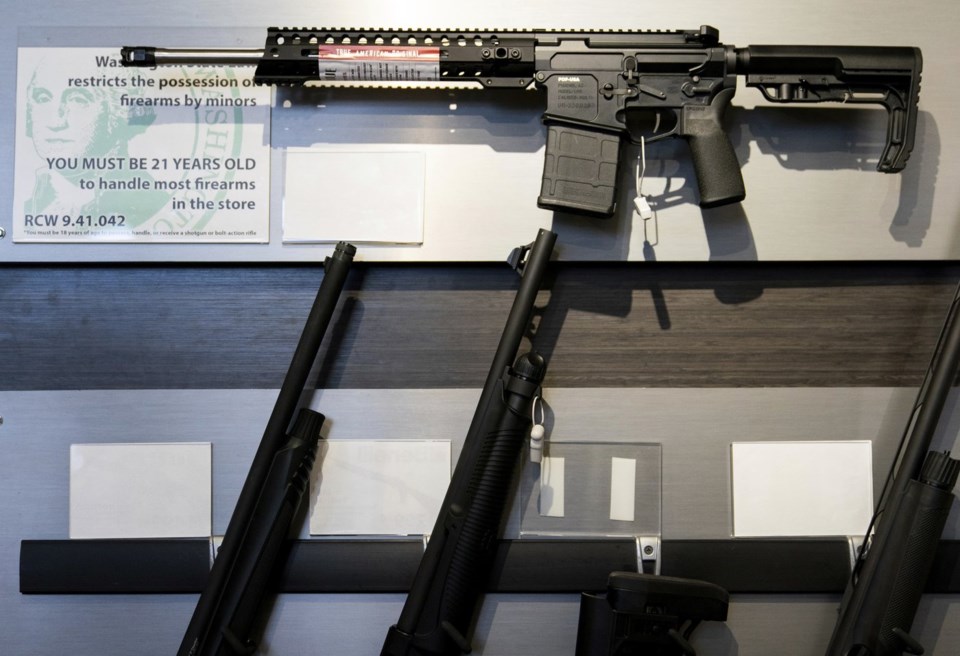WASHINGTON (AP) — A split Supreme Court declined on Monday to hear a challenge to a state ban on assault weapons, semiautomatic rifles that are popular among gun owners and that have also been used in multiple mass shootings.
The majority did not explain its reasoning in turning down the case, as is typical. But three conservative justices on the nine-member court publicly noted their disagreement, and a fourth said he is skeptical that such bans are constitutional.
Justices Samuel Alito and Neil Gorsuch said they would have taken the case, and Justice Clarence Thomas wrote separately to say the law likely runs afoul of the Second Amendment.
“I would not wait to decide whether the government can ban the most popular rifle in America,” Thomas wrote. “That question is of critical importance to tens of millions of law-abiding AR–15 owners throughout the country.”
Justice Brett Kavanaugh agreed with the decision to pass on the case now, but he said that he is skeptical that such bans are constitutional and that he expects the court will address the issue “in the next term or two.”
The Maryland law was passed after the 2012 shooting at Sandy Hook Elementary School in Connecticut that killed 20 children and six adults. The shooter was armed with an AR-15, one of the firearms commonly referred to as an assault weapon.
Several states have similar measures, and congressional Democrats have also supported the concept. The challengers had argued that people have a constitutional right to own the firearms like the AR-15.
The case comes three years after the high court handed down a landmark ruling that expanded Second Amendment rights and spawned challenges to firearm laws around the country.
Ten states and the District of Columbia have similar laws, covering major cities like New York and Los Angeles. Congress allowed a national assault weapons ban to expire in 2004.
Gun rights groups argue that banning the popular weapons violates people's Second Amendment rights. Attorneys for Maryland contend the guns aren’t protected by the Second Amendment because they’re similar to military-grade weapons.
The law bans dozens of firearms — including the AR-15, the AK-47 and the Barrett .50-caliber sniper rifle — and puts a 10-round limit on gun magazines.
Thomas and Kavanaugh have previously expressed skepticism about assault weapon bans.
As an appeals court judge in 2011, Kavanaugh wrote a dissent saying that a similar measure in Washington, D.C., was unconstitutional. Thomas, meanwhile, dissented in 2015 when the Supreme Court declined to hear a challenge to a municipal ban on AR-15-style weapons, writing that the “overwhelming majority” of people who owned the weapons used them for lawful purposes like self-defense.
The high court in 2022 handed down a ruling that expanded gun rights and told lower-court judges they should no longer consider factors like public safety in deciding whether firearm laws are constitutional. Instead, they should focus on whether a law fits into the nation’s historic tradition of gun ownership, the court said.
That led to a flurry of challenges to gun laws around the country, multiple restrictions struck down, and confusion among lower-court judges over what gun laws can stay on the books.
Since then, the Supreme Court has overturned a ban on rapid-fire gun accessories called bump stocks but upheld a law barring people under domestic-violence restraining orders from having guns and regulations on nearly untraceable ghost guns.
___
Follow the AP’s coverage of the U.S. Supreme Court at https://apnews.com/hub/us-supreme-court.
Lindsay Whitehurst, The Associated Press



